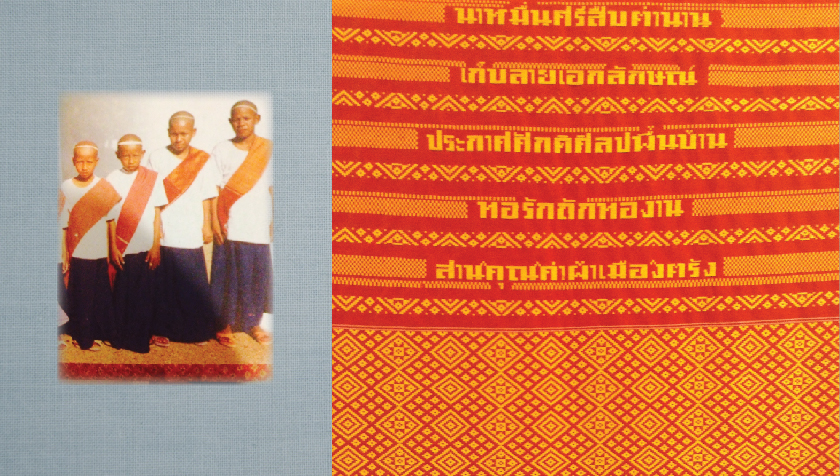
“ผ้า” สื่อกลางระหว่างความเชื่อกับพิธีกรรม: กรณีศึกษา ผ้านาหมื่นศรี อำเภอนาโยง จังหวัดตรัง
“Textiles,” as the Mediums of Belief and Ritual: A Case Study of Na Meun Sri Textiles, Na Yong District, Trang Province
โดย ชนกมลย์ คงยก / By Chanakamol Kongyok
Damrong Journal, Vol 14, No.1, 2015
บทคัดย่อ:
ผ้าและเครื่องถักทอนับเป็นของใช้ที่แสดงถึงความคิดริเริ่มและการสร้างสรรค์ของมนุษย์ โดยเฉพาะ ผ้าทอพื้นเมืองที่แต่ละถิ่นแต่ละภาคมีรูปแบบของสีสัน ลวดลาย และกรรมวิธีการผลิตที่แตกต่างกันไป แม้ว่าจะผลิตขึ้นจากวัตถุดิบประเภทเดียวกันคือไหมหรือฝ้าย การทอผ้าจึงนับว่าเป็นงานหัตถศิลป์ที่น่าสนใจแขนงหนึ่ง นอกจากหลักฐานการพบชิ้นส่วนของผ้าในสถานที่ต่างๆของประเทศไทยจะเป็นสิ่งที่ช่วยยืนยันถึง การเคลื่อนย้ายทางวัฒนธรรมของกลุ่มคนแล้ว ผ้ายังช่วยสะท้อนถึงความสัมพันธ์ทางสังคม วัฒนธรรม การเมือง เศรษฐกิจ ของกลุ่มคนในชุมชนนั้นได้อีกด้วย
จากการศึกษาค้นคว้าในเบื้องต้นพบว่า มีผ้าภาคใต้ที่น่าสนใจหลายชิ้น ได้แก่ ผ้าทอราชวัตร จังหวัดสงขลา, ผ้านาหมื่นศรี จังหวัดตรัง, ผ้ายกเมืองนคร จังหวัดนครศรีธรรมราช, ผ้าพุมเรียง จังหวัดสุราษฎร์ธานี และผ้าจวนตานี จังหวัดปัตตานี ซึ่งการศึกษาที่ผ่านมาเป็นศึกษาเกี่ยวกับการให้ความหมายของลวดลายผ้า การประดับตกแต่งร่างกาย และการแสดงออกถึงสถานะทางสังคม หากแต่ยังขาดในประเด็นเชิงบทบาทหน้าที่ของผ้าในบริบทพิธีกรรมท้องถิ่น ความสนใจเรื่องผ้าและเครื่องถักทอของผู้วิจัยในครั้งนี้ได้ศึกษาผ้านาหมื่นศรี อำเภอนาโยง จังหวัดตรัง ซึ่งผู้วิจัยพบว่าเป็นผ้าที่มีความเกี่ยวข้องกับพิธีกรรมและมีความสัมพันธ์กับคนในท้องถิ่นเป็นอย่างมาก ประเด็นการศึกษาจึงให้ความสำคัญกับผ้าในฐานะเป็น “สื่อกลาง” เชื่อมโยงระหว่างโลกเบื้องหน้า โลกแห่งความศักดิ์สิทธิ์ หรือโลกแห่งจิตวิญญาณ เข้ากับโลกแห่งความเป็นจริงของผู้คน สังคม ประเพณี และวัฒนธรรม ผ่านการประกอบพิธีกรรมท้องถิ่น
ABSTRACT:
Clothes and textiles are materials which reflect human originality and creativity, especially domestic fabrics representing unique patterns, colors, and the production methods of each region. This is despite the same materials being used in the production of the fabric, which are either silk threads or cotton. Fabric weaving can, then, be regarded as one of the interesting aspects of the craftsmanship.
The discovery of pieces of textiles in various regions of Thailand can indicate the changes and movements of various cultures and groups of people as well as reflecting the social, cultural, political, and economic relationships between those people.
The initial research found that there are many interesting pieces of Southern textiles, which are Ratchawat fabric from Songkhla Province, Nakhon brocade from Nakhon Sri Thammarat, Pumriang fabric from Suratthani, and Juantani fabric from Pattani. While the previous research has covered the definition of the textile patterns, the decoration of the fabric on the body, and the representation of social status through clothes, there still needs to be more exploration of the issue of the roles of textiles in the context of local rituals.
The author’s interest in textiles and weaving has inspired the research of Na Meun Sri fabric from Nayong District, Trang Province. This type of textile has a connection to the rituals and the local people. The research focuses on the role of textiles as the “medium” connecting the world to the afterlife, the world to the holy, the world of the spirits to the world of earthly people, society, traditions, and culture through local ritual performance.











